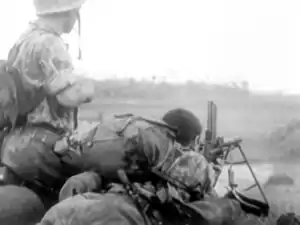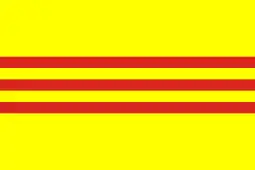FM 24/29 light machine gun
The Fusil-mitrailleur Modèle 1924 M29 (or MAC 24/29), designed in 1924 by the Manufacture d'Armes de Châtellerault, was the standard light machine gun of the French Army from 1925 until the 1960s and was in use until 2000-2006 with the National Gendarmerie. A robust and reliable weapon, it equipped the French army for much of the twentieth century and had the reputation of being a trustworthy and quality weapon.
| FM 24/29 | |
|---|---|
 LMG 24/29 | |
| Type | Light machine gun |
| Place of origin | France |
| Service history | |
| In service | 1925–1979 (French Army) 1956–2008 (Gendarmerie nationale) |
| Used by | See Users |
| Wars | Rif War World War II First Indochina War Algerian War Suez Crisis 1958 Lebanon crisis Vietnam War Cambodian Civil War Laotian Civil War Lebanese Civil War |
| Production history | |
| Designer | Lt col. Reibel assisted by Chief Armorer Chosse |
| Designed | 1920-1924 |
| Manufacturer | Manufacture d'Armes de Châtellerault |
| Unit cost | ? |
| Produced | 1925-1960s (232,942 units) |
| Variants | M1924-M29D M1931 |
| Specifications | |
| Mass | 8.9 kg (19.7 lb) |
| Length | 1080 mm (42.5 in) |
| Barrel length | 500 mm (19.5 in) |
| Cartridge | 7.5×54mm French |
| Caliber | 7.5mm |
| Barrels | 1 |
| Action | Gas-operated Bolt-link |
| Rate of fire | 450 rpm |
| Muzzle velocity | 830 m/s (2,722.4 ft/s) |
| Effective firing range | 1250 m (3,937 ft) |
| Maximum firing range | 3950 m (12,959 ft) |
| Feed system | 25 round detachable box magazine |
| Sights | Iron sights |
It fires the French 7.5×54mm round which is equivalent in ballistics and striking power to the later 7.62×51mm NATO (.308 Winchester) and 7.62×54mmR round. Partly derived from the M1918 Browning Automatic Rifle (BAR) action, the FM 1924 M29 soldiered on, almost without interruptions, for more than 50 years.
History
The Chauchat rifle machine gun, hastily developed under the pressure of the events of the First World War, gave way around 1925 to the new FM MAC 1924 which fired the brand new 7.5mm 1924C (7.5x58mm) cartridge. After a series of accidents with reused captured German weapons during training, chambering the 7.92x57, too close to the new ammunition, the MAC 1924 was adapted in 1929 to the 7.5x54mm 1929C ammunition after some modifications (change of magazine and barrel) to become the MAC 1924/29. This model would be called FM 24/29 by the French infantry. It was gradually replaced in the early 1960s by the AA-52.
Development
After the end of World War I, the French Army sought to replace the problematic Fusil-mitrailleur mle 1915 CSRG light machine rifle (better known as the Chauchat). French commanders considered standardizing on the American Browning Automatic Rifle (BAR), but eventually required the development of a locally built weapon. MAS (an abbreviation of Manufacture d'Armes de St. Etienne - one of several government-owned arms factories in France) proposed a direct derivative of the BAR, but the Manufacture d'Armes de Châtellerault (MAC) won the bid with its weapon, which was partly derived from the BAR action. It had been formulated and designed by a Lieutenant Colonel Reibel assisted by Chief Armorer Chosse.
The FM Mle 1924 entered production in late July 1925 and saw first operational use in Morocco in May 1926. It was immediately well-received and even favorably compared in performance with the much heavier Hotchkiss machine gun. However, problems created by the new 7.5mm ammunition did appear. In particular, 8×57mm Mauser ammunition which was used in captured Mauser rifles carried by auxiliaries in Morocco during the Rif War from 1920–26, could be chambered and fired with disastrous results. This situation led to the development of a slightly shorter 7.5×54mm round, which was retained in 1929 as the standard ammunition for all future rifles and light machine guns in French service. The modified fusil-mitrailleur modèle 1924 modifié 1929 (FM Mle 1924 M29) was mass-manufactured (187,412), beginning in 1930. In addition to these newly manufactured guns some 45,530 older FM Mle 1924s, already in service after phasing out the Chauchat, were rebarreled in order to accept the newer 7.5×54mm ammunition.
Both the original fusil-mitrailleur Mle 1924 (rifle machine gun, model of 1924) as well as the modified Mle 1924 M29 have the same overall features: a folding bipod, an in-line stock, a pistol grip, a top-mounted 25-round detachable magazine and a bolt hold-open after the magazine's last round had been fired. There are two separate triggers: the trigger in front for using semi-automatic fire only and the rear trigger for firing on full automatic. Protection of all the openings against mud and dust proved excellent. The cyclic rate was controlled at 450 rounds per minute, thus allowing more continuous firing without overheating. In general, this new weapon was accurate and highly reliable but the barrel was screwed well into the receiver, as in the Browning Automatic Rifle (BAR), and thus it could not be separated quickly and easily in the field as for the Czech ZB vz. 26 and its British variant, the Bren gun. The French Army instruction manual (July 1925) recommends not to go beyond 400 rounds of uninterrupted firing since at that point the gun needs to be given a pause of ten to fifteen minutes in order to cool off. But instead, the French instruction manual recommends the following routine for the FM 1924: fire 4 to 5 detachable magazines (100 to 125 rounds), take a short pause, then keep repeating that same restrained fire plus short pause routine which permits steady performance and very extensive firing periods.
Prototype: the MAC 1924
This model comes from the MAC 1923 prototype of the Châtellerault arms factory, winner of several test campaigns against the FM MAS 1922, the Hotchkiss Model 1922, the Lewis Mark I and Browning BAR M1918. The new model was delivered from the end of July 1924. It is the only French weapon produced industrially to have used the ephemeral 7.5mm 1924C cartridge. Prototypes of MAS semi-automatic rifles were also adapted with this cartridge until the ban on firing this ammunition.
Description of the FM 24/29
It has characteristics in common with many FMs of its time. It fires either shot by shot or in unlimited bursts (two triggers). Its stock, pistol grip and barrel are made of wood. Its rectangular magazine is placed on the top of the weapon, shifting the rear sight and front sight to the left, which is imperative for right-handed people. It also has a sideways folding front bipod and can accommodate a crutch under the buttstock. It could be mounted on a sidecar or in vehicle ports thanks to a position reserved in its handguard. Its leather strap, robust and efficient, has a metal hook allowing the user to switch from the carrying position to the firing from the hip position in an instant.
The book La Manufacture Nationale d'Armes de Châtellerault, a technical history of all the military firearms developed and manufactured at Chatellerault, includes a highly detailed technical chapter dealing with the FM Mle 1924 and Mle 1924-M29.
Operational use

This weapon was very appreciated by the soldiers of the French army who would use it for the first time in combat on May 11, 1926 during the Rif War. The FM 24/29 was the standard squad-level automatic weapon of the French infantry and cavalry at the start of World War II. After the French surrender in 1940, the Germans captured large quantities of this weapon, which they used operationally until the end of the war, under the designations of MG 115(f) and MG 116(f).
Those weapons were used on the Russian front by supplementary units of the German army which were partially equipped with them. Some examples of the FM 24/29 are displayed in the ex-Soviet museums devoted to the "Great Patriotic War". The MAC 24/29 was also used in limited numbers by the Finnish Defence Forces during the Winter War and the Continuation War.
From 1943 on, as the French army was re-equipped and reorganized in North Africa with Allied support, the FM 24/29 was kept in service, as French troops considered it superior to the Browning Automatic Rifle (BAR).
The FM 24/29 was the workhorse in the First Indochina War, as the infantry squad weapon and mounted in jeeps in the SAS style. The FM 24/29 served in the armed forces until after the end of the war in Algeria.[1] The FM 24/29 was replaced by the AA-52 general-purpose machine gun in the 1960s in frontline service, but would remain for a long time as the collective weapon of the regiments of the General Reserve of the French Army, stored in the Mobilizing Centers across the country until the mid-1980s.[2] The FM 24/29 was still in use with the National Gendarmerie regional brigades until 2000-2006.[2]
Withdrawn from active service around 1965, the FM 24/29 became the collective weapon in the general reserve, as it did in the National Police (mainly CRS) and the National Gendarmerie. Thus all the departmental gendarmerie brigades were to be equipped with the FM 24/29 at the rate of one collective weapon per 10 to 15 non-commissioned officers, and its withdrawal from service would only take place in 2006 (the 7.5 MAS ammunition no longer being supplied), including in the reserves of the Mobile Gendarmerie squadrons.
Most of the MAC 24/29 would be ceded to former French colonies in Africa during the decolonization process (Algeria, Benin, Cameroon, Central African Republic, Comoros, Congo, Ivory Coast, Djibouti, Gabon, Guinea , Guinea-Bissau, Madagascar, Morocco, Mauritania, Niger, Senegal, Seychelles and Chad). At least 200 examples were used by the Israeli Defense Forces in the Israeli War of Independence.
Likewise, it was supplied to the auxiliaries raised in Cambodia, Laos and in the State of Vietnam during the Indochina War. It thus found itself in the hands of the Viet Minh. During the Vietnam War, the MAC 24/29 continued its Indochinese military career in the ranks of its former enemies of the Viet Cong and the People's Army of Vietnam, as well as with the Army of the Republic of Vietnam (ARVN) and its paramilitary units. The FM 24/29 kept soldiering on during the Vietnamese occupation of Cambodia up to 1989.
Variants
Model 1924/1929D machine gun

The FM 24/29D, with a longer, thicker barrel, fired a heavy bullet variant (7.5mm 1933D cartridge) of its original ammunition. It was intended for the casemates of the Maginot Line[3][4][5][6] where it was quickly replaced in this role by the Reibel machine gun. After the armistice of June 1940, the German occupiers recycled a good number of examples on the Atlantic Wall.[7][8][9][10][11]
M1931
A derivative of the gun, the MAC Modèle 1931, with a heavier barrel and 150-round side-mounted pan magazine, was produced as a heavy machine gun for installation in tanks and fortified emplacements, particularly the Maginot Line. It is also sometimes known as the JM Reibel, which actually stands for Jumelage de mitrailleuses Reibel (Reibel twin-mounted machine guns). The Reibel was mounted in jeeps in the SAS style during the Indochina War.
Users
 Algeria[12]
Algeria[12] Benin[13]
Benin[13] Central African Republic[13]
Central African Republic[13] Republic of China
Republic of China Republic of the Congo[13]
Republic of the Congo[13] Djibouti[14]
Djibouti[14] Finland: 100 received from France and used during the Winter War[15] and the Continuation War.
Finland: 100 received from France and used during the Winter War[15] and the Continuation War. France: First adopted by French Army in 1924.[16] Also saw service with the National Gendarmerie.[17]
France: First adopted by French Army in 1924.[16] Also saw service with the National Gendarmerie.[17] Israel: At least 200 were in service with the IDF, possibly more prior to the formation of the IDF. A 1942 dated field manual was written or translated by the Haganah. The gun was referred to as "מקלע צרפתי שטו," or "French machine gun château," a corruption of "Châtellerault," where the FM 24/29 was made.
Israel: At least 200 were in service with the IDF, possibly more prior to the formation of the IDF. A 1942 dated field manual was written or translated by the Haganah. The gun was referred to as "מקלע צרפתי שטו," or "French machine gun château," a corruption of "Châtellerault," where the FM 24/29 was made.

 Ivory Coast[13]
Ivory Coast[13].svg.png.webp) Kingdom of Laos: Received by French Government during First Indochina War.[18]
Kingdom of Laos: Received by French Government during First Indochina War.[18] Lebanon[13]
Lebanon[13].svg.png.webp) Nazi Germany: Captured weapons. The mle 1924/29 served as Leichtes MG 116(f).[19] The few surviving Mle 1924 models were given the designation Leichtes MG 115(f).[20]
Nazi Germany: Captured weapons. The mle 1924/29 served as Leichtes MG 116(f).[19] The few surviving Mle 1924 models were given the designation Leichtes MG 115(f).[20] Niger[21]
Niger[21].svg.png.webp) North Vietnam (Viet Minh and Viet Cong),[22][23] known as Vĩnh Cát, from the French vingt quatre (24).[24]
North Vietnam (Viet Minh and Viet Cong),[22][23] known as Vĩnh Cát, from the French vingt quatre (24).[24] South Vietnam (Vietnamese National Army and Army of the Republic of Vietnam).[25]
South Vietnam (Vietnamese National Army and Army of the Republic of Vietnam).[25]
See also
References
- "L'armement français en A.F.N." Gazette des Armes (in French). No. 220. March 1992. pp. 12–16.
- "Le FM 24/29". Les Dossiers de la 2e Guerre Mondiale. No. 7: 64–65. 2007.
- "armement reglementaire francais les fusils mitrailleurs". armesfrancaises.free.fr. Retrieved 2020-12-25.
- Kaufmann, J. E. (2017). The Maginot Line : history and guide. Barnsley, South Yorkshire. ISBN 978-1-5267-1151-9. OCLC 971032695.
- Allcorn, William (2003). The Maginot Line, 1928-45. Vanelle, Jeff., Boulanger, Vincent. Oxford: Osprey. ISBN 1-84176-646-1. OCLC 56538717.CS1 maint: date and year (link)
- Romanych, Marc (2010). Maginot Line 1940 : battles on the French frontier. Rupp, Martin., White, John. Oxford: Osprey. ISBN 978-1-84603-499-2. OCLC 320186975.CS1 maint: date and year (link)
- Williams, Paul R. (2013). Atlantic Wall : Pas de Calais. Barnsley, South Yorkshire: Pen & Sword Military. ISBN 978-1-78303-666-0. OCLC 854876661.CS1 maint: date and year (link)
- Zaloga, Steve (2005). D-Day fortifications in Normandy. Johnson, Hugh. Oxford: Osprey. ISBN 1-84176-876-6. OCLC 61529026.CS1 maint: date and year (link)
- Zaloga, Steve (2007–2015). The Atlantic Wall. Johnson, Hugh, 1971-, Hook, Adam. Oxford, UK: Osprey Pub. ISBN 978-1-84603-129-8. OCLC 84151448.CS1 maint: date and year (link) CS1 maint: date format (link)
- Zaloga, Steve (2009). The Atlantic Wall. 2, Belgium, the Netherlands, Denmark and Norway. Johnson, Hugh, 1971-, Hook, Adam. Oxford: Osprey Pub. ISBN 978-1-84908-125-2. OCLC 645484351.CS1 maint: date and year (link)
- Zaloga, Steve (2013). The devil's garden : Rommel's desperate defense of Omaha Beach on D-Day. Mechanicsburg, PA. ISBN 978-0-8117-1228-6. OCLC 828488810.
- Windrow, Martin (1997). The Algerian War, 1954-62. Men-at Arms 312. London: Osprey Publishing. p. 22. ISBN 978-1-85532-658-3.
- Gander, Terry J.; Cutshaw, Charles Q., eds. (2001). Jane's Infantry Weapons 2001/2002 (27th ed.). Coulsdon: Jane's Information Group. ISBN 9780710623171.
- "World Infantry Weapons: Djibouti". 2007–2015. Archived from the original on 24 November 2016. Retrieved 21 November 2018.
- Jowett, Philip; Snodgrass, Brent (5 Jul 2006). Finland at War 1939–45. Elite 141. Osprey Publishing. p. 50. ISBN 9781841769691.
- http://world.guns.ru/machine/fr/mac-m1924-e.html
- armesfrancaises.free.fr/FM Mle 24-29.html
- Conboy, Kenneth (23 Nov 1989). The War in Laos 1960–75. Men-at-Arms 217. Osprey Publishing. p. 15. ISBN 9780850459388.
- Chris Bishop (2002). The Encyclopedia of Weapons of World War II. Sterling Publishing Company, Inc. p. 241. ISBN 978-1-58663-762-0.
- Peter Chamberlain; Terry Gander (1974). Machine guns. Arco Pub. Co. p. 15. ISBN 978-0-668-03608-5.
- "World Infantry Weapons: Niger". 2007–2014. Archived from the original on 24 November 2016.
- Windrow, Martin (15 Nov 1998). The French Indochina War 1946–54. Men-at-Arms 322. Osprey Publishing. p. 24. ISBN 9781855327894.
- Chris Bishop (1996). Vital Guide to Combat Guns and Infantry Weapons. p. 203. ISBN 1853105392.
- "Những vũ khí viện trợ đã ra trận cùng QĐVN trong trận Điện Biên Phủ". tintuc.vn (in Vietnamese). 11 November 2014.
- Gordon L. Rottman (2010). Army of the Republic of Vietnam 1955–75. Men-at-Arms 458. Osprey Publishing. p. 43. ISBN 9781849081818.
Bibliography
- Ferrard, Stéphane. France 1940 l'armement terrestre, ETAI, 1998. ISBN 978-2-7268-8380-8.
- Philippe Truttman, La Muraille de France ou la Ligne Maginot, Gérard Klopp éditeur, 1985.
- Huon, Jean. Les armes françaises en 1939-1940, Éditions Crépin-Leblond, 1st April 2006.
- Huon, Jean. Les armes françaises en Indochine: Tome 1, Éditions Crépin-Leblond, 13 January 2009.
- Huon, Jean. Les armes françaises en Indochine: Tome 2, Éditions Crépin-Leblond, 13 January 2009.
- Claude Lombard, La Manufacture Nationale d'Armes de Chatellerault, 1987, Editor : Brissaud,162 Grande Rue, Châtellerault. A technical history of all the military firearms developed and manufactured at Chatellerault . This volume includes a highly detailed technical chapter dealing with the FM Mle 1924 and Mle 1924-M29. ISBN 2-902170-55-6.
- "Instruction Provisoire de Juillet 1925 sur le Fusil-Mitrailleur 1924", Charles-Lavauzelle & Cie, Paris, 1928.